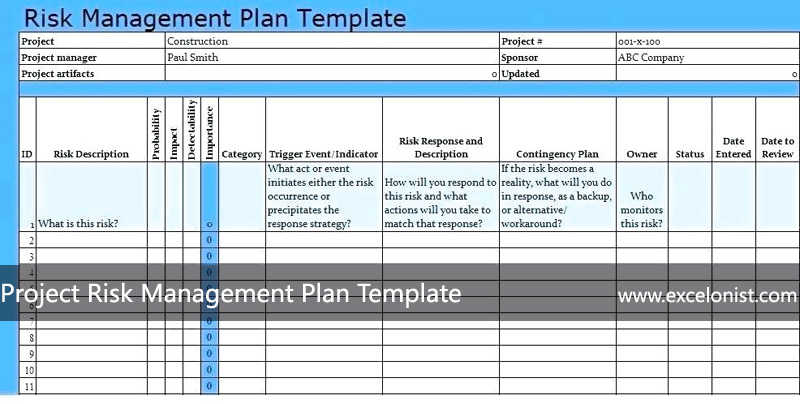A project management list of potentialities that might affect the timeline, performance, or project budget over its life cycle is considered a risk. It is a key responsibility of project managers to identify, analyze and make mitigation strategies to avoid any possible issues during the project life cycle.
Thank you for reading this post, don't forget to subscribe!It is part of planning to identify and evaluate beforehand what might goes wrong during the life cycle of the project. It may sound negative, but issues will certainly come out and managers need to have mitigation strategies.
A project risk template is a matrix formed after the identification of possible risks, their categorization, prioritization, and mitigation action plans. It represents all critical information that is necessary for risk management during the project life cycle.
Project Risk Management Plan
As we know, a risk management plan is part of a project, thus when we crate a risk plan, we follow these management approaches and strategies.
- Avoid
- Mitigation
- Transfering
- Acceptance
In the first part “avoid” project managers prefer to avoid facing problems, this approach may or may not damage your project depending on the issue. You can easily find the root cause analysis tools here.
Mitigation is the process of doing action against the issues and problems, so in this managerial approach project managers create contingency plans.

In this phase of transferring, we can hire external companies or project managers, or management teams that can handle problems or management issues. But this kind of outsourcing may increase project expenses.
Acceptances refer to the failure of a project because in this phase project managers can not eliminate or reduce the impact of the problem on project progress.
Why Project Risk Management Plans Are Created?
After making a project plan, a risk management plan is also needed to prepare because in real-time scenarios we may face different kinds of problems and issues. So, to make run a project smoothly, every project plan needs a risk plan.
Sometimes, the project managers make a contingency plan or corrective action plan. These plans help to make changes in a running project according to conditions and progress. This managerial technique helps to complete a project in time and reduce extra costs or labor expenses, etc.
How to Make A Project Management Risk Plan
There are several strategies and approaches to making a project risk template. Risk management has two dimensions: risk assessment and mitigation strategy. Risk assessment involves the identification, categorization, and prioritization of risk.

Brainstorming sessions and 5Ws approaches are common in the identification of risks. Mitigation strategies are actions that should be taken to minimize the likelihood of risk occurrence and impact on the project milestone | project timeline.
The main focus of these approaches is to extract all information that is necessary to make the project risk template.
The following information must be written on the project risk template for its usefulness,
- Risk Description
- The likelihood of the risk occurring
- Impact (If the risk occurs)
- Severity (Rating based on Impact and Likelihood)
- Risk Score
- Time limit
- Responsible (Person who will manage the risk)
- Mitigation Action (Actions to mitigate the risk)
What are the Significances of the Project Risk Template?
Project risk management includes risk assessment and making mitigation strategies to deal with those risks it becomes issues. Risks are the possibilities when it becomes realities those are called issues.
The project manager’s duty is to minimize the likelihood of risk becoming an issue and in case it happens there must be some action plan to minimize its impact.
There are two approaches to risk management. The project risk management template comes under a preventive approach to risk management.
The success of a project manager is to classify are possible risks under a preventive approach still if something unexpected happens reactive approach comes to application to reduce the severity of its impact on the project life cycle.
In a preventive approach, risk identification is a creative process in which brainstorming sessions are arranged where critical members of the team are being asked to enlist any possibilities that may happen during the project life cycle which may impact it in any way.

These sessions are initially conducted based on the concept of “There’s no such thing as a bad idea”. Members are encouraged to put forward ideas that may later be filtered in the evaluation stage.
Risks are categorized based on their likelihood of occurrence and severity of impact.
Following are examples of potential risk categories,
- Technical
- Financial
- Schedule
- Weather
- Political
- Environmental
- People
In conclusion, after the planning stage in the project management project risk template is made to make sure the successful implementation of the project plan as per the defined project life cycle.
It enlists all potential challenges that would come up with their mitigation strategies to strictly follow to minimize their impact on the project in any way.





Insightful
Thanks for your appreciation Sabelo.
What are the Significances of the Project Risk Template?PLEASE ASSIST WITHT THE TEMPLATE